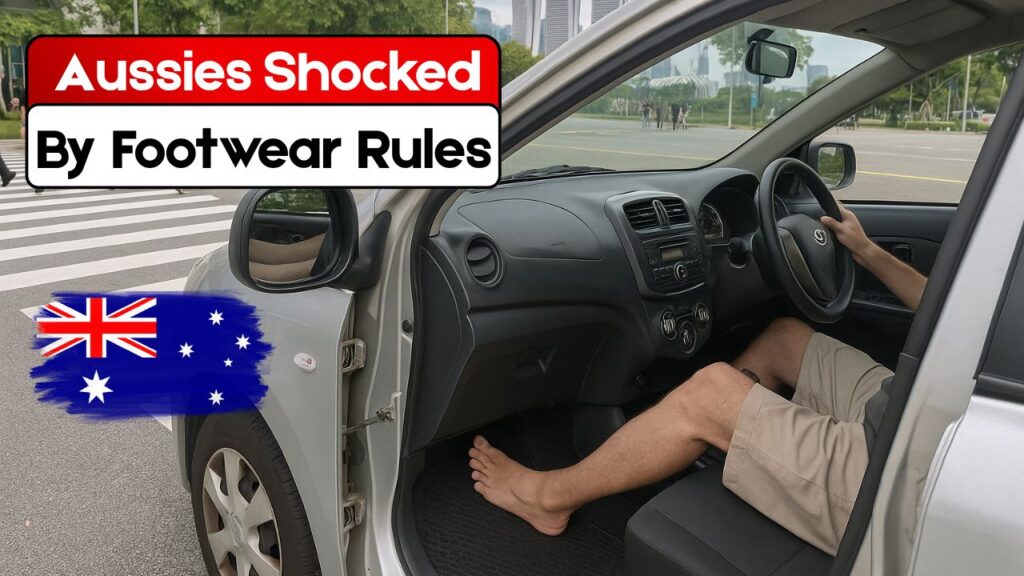Driving in Australia is a relaxed experience for many, but when it comes to footwear — or the lack of it — things can get surprisingly complicated. As summer rolls around, many Australians prefer to slip into flip-flops or even drive barefoot, especially during beach trips. But the question remains: is it legal to drive without shoes? The Australian driving laws for 2025 clarify what’s allowed and what might get you fined. Understanding these road safety rules can save you from unexpected penalties and ensure a safe journey across the country.

Driving Barefoot in Australia – Legal or Not?
According to the Australian road regulations, it is technically not illegal to drive barefoot or in flip-flops. However, authorities like Transport NSW and Queensland Police warn that footwear choices can affect control of the vehicle. If your driving performance is compromised due to inappropriate footwear, you can face fines for negligent driving. So while barefoot driving may seem harmless, it’s crucial to ensure your feet have enough grip and comfort for safe pedal control. The safest approach is to choose secure footwear when driving long distances or on busy roads.
Flip-Flops and Fines – Understanding the Risks
Wearing loose flip-flops while driving can cause your foot to slip or get caught under the pedal, creating a dangerous situation. Police officers have the authority to fine or penalize drivers if such footwear leads to unsafe driving behavior. While fines differ by state, most Australian territories apply general rules under the negligent driving clause. In extreme cases, accidents caused by poor footwear choices can also affect your insurance claim. To stay safe, experts suggest keeping a pair of closed shoes in your car, especially if you plan on long trips or hilly terrain.
State-Specific Guidelines and Penalties for 2025
Different Australian states may interpret barefoot or flip-flop driving differently. For instance, Victoria’s road authority emphasizes driver control, while Western Australia Police highlight the importance of driver responsibility. There are no direct bans, but officers can issue fines if your footwear leads to reckless driving or loss of vehicle control. The focus remains on maintaining safety and preventing avoidable mishaps. In short, while barefoot driving isn’t directly illegal, it could still result in financial penalties if linked to unsafe behavior behind the wheel.
| State/Territory | Rule on Barefoot Driving | Potential Fine (2025) | Authority |
|---|---|---|---|
| New South Wales | Not illegal but discouraged | Up to $457 | Transport NSW |
| Queensland | No specific law, driver responsibility | Up to $575 | Queensland Police |
| Victoria | Allowed, but must maintain control | Up to $476 | VicRoads |
| Western Australia | No direct restriction | Up to $500 | WA Police |
| South Australia | Permitted but not recommended | Up to $480 | SA Police |
Why Safe Footwear Matters on Australian Roads
Even though barefoot or flip-flop driving isn’t technically banned, the underlying concern lies in driver safety. Proper footwear helps maintain grip, improves reaction time, and reduces the risk of foot strain during long drives. With road accidents still a key issue in 2025, authorities encourage drivers to wear comfortable shoes that allow full pedal control. Whether cruising along the Great Ocean Road or navigating city traffic, smart footwear choices can make a big difference in safety. Remember, comfort is fine — but safety always comes first behind the wheel.
FAQ 1: Is driving barefoot illegal in Australia?
No, it’s not illegal, but unsafe control could lead to fines.
FAQ 2: Can I wear flip-flops while driving?
Yes, but if they affect control, you can be penalized under negligence.
FAQ 3: Which state has the highest fine for unsafe footwear?
Queensland imposes one of the highest fines, up to $575.
FAQ 4: What’s the safest footwear for driving?
Closed, flat shoes with good grip are considered safest for drivers.






